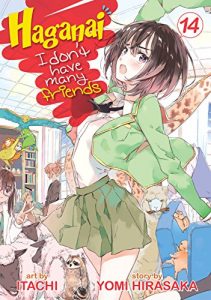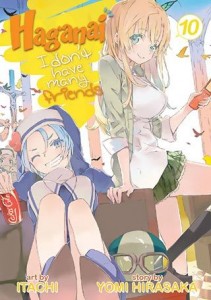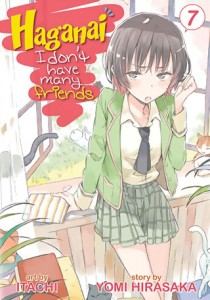By Yomi Hirasaka and Itachi. Released in Japan as “Boku wa Tomodachi ga Sukunai” by Media Factory, serialization ongoing in the magazine Comic Alive. Released in North America by Seven Seas. Translated by Ryan Peterson. Adapted by Ysabet Reinhardt McFarlane.
(Note: please do not post light novel spoilers in the comments.)
Most harem manga these days have to walk a very thin tightrope, especially in a modern, internet-forum friendly world. readers want the hero to end up with the girl they like best, and every time that things return to the status quo they are upset. Writers and editors want this to be successful for as long as possible, which means stringing things out and returning to status quo without making it look too obvious. With Haganai, the Neighbors Club has been the way to do this, as each of the cast is so socially inept that even basic interaction is a challenge, much less having a significant other. Or at least, that’s what Kodaka tells himself. In fact, Kodaka is very good at lying to himself and others, and the astute reader of Haganai has, through several books now, been feeling more and more like Rika, watching this play out and getting increasingly angry. This is the volume where that rage finally explodes.
This kicks off with a seeming resolution of the perpetual love triangle between Kodaka and the two female leads. Yes, there are more than two love interests, but at heart it’s always been about Yozora vs. Sena. More on Yozora later, but I felt that Sena’s confession was first rate. Yes, it started out as her seemingly talking to herself while gaming, as if practicing for later, but once she realizes what actually happened, she doesn’t back off. This makes a start contrast to Kodaka, who literally runs away as fast as possible and hides from the rest of the club for days. His desire for stasis has never been more contemptible than it is here, particularly given that he spends said days with the Student Council, the Neighbors’ Club’s mortal enemies. To his surprise, they don’t view him as a thug and a bad person, and we see just how much of Kodaka’s self-worth problems are his own doing.
Then comes the scene with Rika. (Yes, there’s a nice scene with Yukimura as well, but while it’s heartwarming, it’s all setup for that one gag. You know the one I mean.) Rika already confronted Kodaka last time about his perpetual “Huh? What was that?” response, and was seen to be barely holding it together. Now she explodes, and it’s glorious. Kudos to Itachi, by the way: the art in Haganai has frequently taken on a sketchy, exaggerated look at times, particularly when it’s funny, and it doubles down on that here, with some amazing faces that would not look out of place in a horror title. Rika beats the shit out of Kodaka (scientifically, of course) as she rants about what she learned from Sena. She’s absolutely right, of course. Of all the girls in the series, Sena has gotten twice the romantic subtext as anyone else. And he’s running away from this because he can’t face up to her actually liking him as more than a friend.
Haganai is caught up with Japan, so it will be many months before we see the next volume. But now that Rika and Kodaka have admitted hey are indeed friends, can he man up and listen to Sena? More importantly, what about Yozora, who seemingly heard this entire exchange, and whose devastated sobbing face ends this arc? The artist notes that the manga may be a bit different from the light novels, though it’s unclear if that means additions or actual changes. In any case, for those who were waiting for the payoff in Haganai, here’s where it starts.



